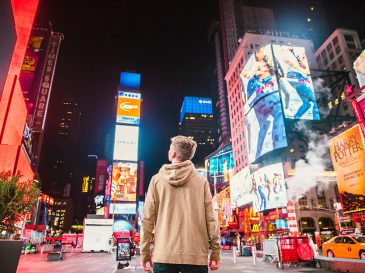With the recent announcement of the new umbrella name “Meta,” the Facebook/Instagram/WhatsApp behemoth is shifting its place of business to the “metaverse.” It seems timely, then, to consider what we mean when we use that term and, particularly, how it can be made transformative and beneficial for children and teens. There is, as yet, no true metaverse, so it’s early enough that all stakeholders can shape a positive trajectory.

In Dubit’s vision, we might start by imagining the metaverse as a constellation of inherently social communities where young people can play, work, learn and explore in ways that aren’t necessarily possible in the real world. Like real-world communities, it won’t be just top-down (designed and controlled by major corporations or governments) but also bottom up (user-generated spaces) and sides out (co-created experiences that may be jointly built by IP owners and fans, or public-private collaborations). If we confront issues like technology and broadband access, the opportunity is there for the metaverse to be globally representative, authentically and deeply diverse beyond any previous digital worlds.
So, who are the people in your metaverse community?
Silicon Valley – Certainly, the big tech companies will have space there; there’s no better evidence than big gaming and social companies buying visual effects companies. Meta will be a massive hardware and software presence in AR, VR and other immersive social and communication platforms. They would be mistaken, however, to think they can “own” the metaverse (in the way that IOI wanted to in Ready Player One), because the generation of kids kickstarting it has grown up expecting to be involved when anyone seeks their attention and trust.
Tweens and teens proved during the pandemic that given access to spaces and tools, they will build the worlds they want—not just accept the worlds they’re offered. When games didn’t provide the simultaneous social experience they sought, they connected on Discord to chat while playing. Students at New Rochelle High School (and several colleges) recreated their school in Minecraft in order to hold a COVID-safe virtual graduation.
The Shopping Mall – Major brands are already growing their metaverse strategies. Nerf – perpetually a top toy with kids – is connecting real-world and digital-world play, with virtual blasters available to Roblox players and identical physical ones in toy stores. Nike has filed for trademark protection on digital goods, virtual stores in which to sell them, and entertainment applications to enhance experiential online shopping. Even Gucci recreated its real-world Florence Gucci Garden in Roblox, inviting exploration, discovery of branded items, and the opportunity to buy them for use on the platform – sometimes at an even higher price than the physical item.
The Strip Mall – Smaller brands will own space in the metaverse, as well. Dubit often talks about “squeezed middle” kid brands – unsustainable as niche “passion brands”, but too small to compete head-to-head with well-resourced mega-brands (e.g., LEGO, Paw Patrol).

Those in the middle have to be more innovative and authentic in discovery and marketing to draw people in. Brands are discovering the benefit of allowing the audience to use their IP in fan fiction, art, and games (as long as the content isn’t detrimental to the brand). This provides free, viral promotion and deepens fan engagement.
Often, small- and mid-size brands take up residence within a bigger platform – putting content with popular brands on MCNs like Moonbug or Wildbrain Spark. Roblox is the metaverse equivalent of these, and Dubit has been building Roblox games for many brands. Others, though, will choose to stake their own claim in order to have full control of their metaverse world. This has been difficult in previous content communities controlled by strong gatekeepers.
The Lemonade Stand – User-generated content already drives massive engagement in proto-metaverse spaces, not just to consume but to create. The openly-available and easily-learned tools for building spaces (Fortnite Creative, Minecraft) or games and experiences (Roblox) power intrinsically-motivated design and coding learning. For some, it’s a pastime or hobby and for others a means of gaining a little in-game currency; however, many young entrepreneurs are building vibrant businesses while doing something they love.
Jeff Bezos says he’s frequently asked what will change in the next 10 years, but seldom what’s not going to change. He adds that the latter is more important “because you can build a business strategy around the things that are stable in time.” There may be nothing more stable than children’s love of creating play and inventing stories.
In the metaverse, a lemonade stand can achieve the same discoverability as a strip mall business if it’s timely and targets an engaged fanbase. In under a month, users created over 100,000 “Squid Game” titles in Roblox, garnering more than 4.3 billion plays.
Hollywood – Perhaps it’s more precise to say the entire global entertainment industry. With millions turning out for concerts and festivals in Fortnite, Roblox, and Minecraft, artists’ promoters are evaluating new ways to be in full control of global performances with no travel or venue fees, and never any brown M&Ms in the dressing room.
Movie and TV companies are struggling a bit more with a metaverse strategy. Clearly, fans will show up for a special event in digital space, but would they go to the cinema? Will kids dive into their daily TV and video watching in a virtual living room? If so, how will the content be organized – will there be a Marvel Cinematic Metaverse “theater” or an immersive space that encompasses all of Disney’s content? Will video spaces look more like Nickelodeon, Netflix, or YouTube – or all of the above? No matter what, video is essential to the success of the metaverse.
Interestingly, the metaverse – and its fans – seem to be reviving the old-school concept of appointment media. When “down on the corner” went “up on the server” during the pandemic, young people scheduled meet-ups in their games of choice to play and socialize. Will video providers, too, improve “watch parties” to create a more VR-like co-viewing experience?
Special events inside platforms are at a set time. Dubit’s new approach to eSports – the Metaverse Gaming League – invites all players to meet up in a particular game at a specific time, for a DJ-led, multi-media play experience not unlike the old-time Saturday morning children’s TV block.
Transport – Virtual communities will be connected in ways that ease current friction points. At present, navigation across platforms or online services is like trying to travel when every bus and train is owned by a different company, using proprietary fare structures with no transfers.Time and space can be compacted in the metaverse.
In the real world, getting from one place to another costs time, money and often frustration. “Location, location, location” is the watchword of land value. In the metaverse, erasing “commuting time” and cost between experiences not only eases the friction of engagement, it also makes any space potentially “prime real estate.”As ever, brands will want to keep people within their own metaverse environments, but part of lowering digital friction and demonstrating authenticity is loosening grip and trusting fans. If, in the real world, you’d want your storefront in a mall where customers can compare and realize your value, you’d want the same in virtual spaces.Creating that ease of movement in a global, always-on space will place a lot of power with the people who design and control its discovery and navigation tools. It’s always been thus: the electronic program guides had enormous say in the recommendation of TV shows, and search engine algorithms (and advertising spend) determine what websites rise to the first page.
Law Enforcement – The metaverse can’t succeed if it’s not a safe space, and balancing young people’s creative autonomy and empowerment with their security may be the biggest tech challenge ever. Everyone from Silicon Valley to the lemonade stands will have to operate under rules that ensure age-appropriate neighborhoods, respectful interaction, and privacy protections. Those rules will include positive protections, as well, like trustworthy age verification and authenticated ownership of virtual goods (NFTs) throughout all spaces.
Over the last 60 years, we have marketed almost every emerging technology first to parents as beneficial for their children, in order to boost market penetration. Only later have we actually studied the real-world effects. As the metaverse is still nascent, we have the rare chance to build thoughtfully and take past successes, failures and missed opportunities into consideration.
The metaverse will be borderless, but the real world isn’t. Emerging regulations like the UK’s Age Appropriate Design Code and business-supported NGOs like the Digital Futures Commission can play a big role developing the rules of the road, but the metaverse community globally will need to evolve and agree on equitable enforcement for everyone from individuals to the biggest corporations.
So, who are the people in your metaverse?
“They’re the people that you meet each day.”
 David Kleeman is SVP of Global Trends for Dubit, a strategy/research consultancy and digital studio. He is advisory board chair to the international children’s TV festival PRIX JEUNESSE, on the Children’s Media Association board, and the Joan Ganz Cooney Center National Advisory Board. He was also a Senior Fellow of the Fred Rogers Center and Board Vice President for the National Association for Media Literacy Education.
David Kleeman is SVP of Global Trends for Dubit, a strategy/research consultancy and digital studio. He is advisory board chair to the international children’s TV festival PRIX JEUNESSE, on the Children’s Media Association board, and the Joan Ganz Cooney Center National Advisory Board. He was also a Senior Fellow of the Fred Rogers Center and Board Vice President for the National Association for Media Literacy Education.

